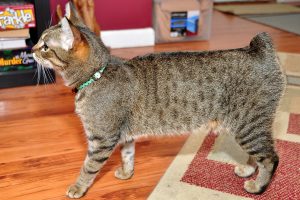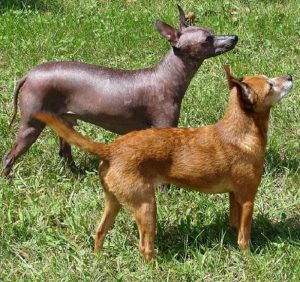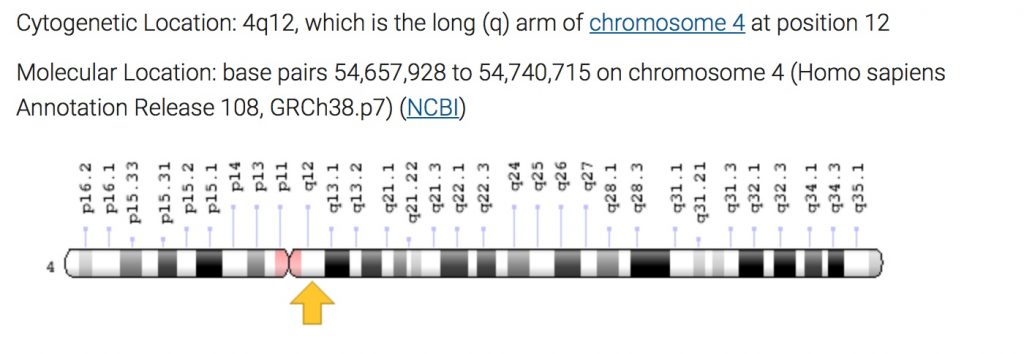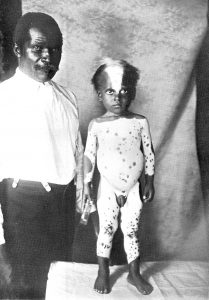KIT – embryonic lethality
Although MITF is the major gene impacting white spotting in dogs, a second gene known as KIT has also been shown to have an impact in a subpopulation of German Shepherd dogs. This mutation in KIT arose very recently (it appeared spontaneously in a female dog born in 2000) and causes a phenotype called “panda spotting.” The KIT gene produces a tyrosine kinase receptor protein that functions in the same melanogenesis pathway as MITF. The KIT receptor controls many important processes within the cells including growth and division, survival, and cell migration. Its signaling function is important in the development of many different types of cells, including melanocytes which product the pigment melanin.
Interestingly, no dogs have been identified that are homozygous for the mutation in KIT. This is probably because having two mutations in this gene is lethal because of its many important functions. This is called a homozygous lethal allele that results in embryonic lethality. There are other examples of embryonic lethal genes:
- The Agouti gene causes coat color changes in many animals, including mice. One mutation that has been isolated in mice causes a yellow colored coat in mice heterozygous for the mutation. Homozygous mice die in the womb (Figure 1).

- Mutations in the FGFR3 gene result in Achondroplasia, a form of dwarfism in humans (Figure 2). This disorder is inherited in an autosomal dominant fashion. Two dominant alleles results in lethality.

- Short legs in dogs, called Chondrodysplasia, are associated with repeats of the FGFR4 gene (Figure 3) (Bannasch, et al. 2022). These mutations have an additive effect and breeds with the shortest legs have a higher rate of mutation frequency.

- Manx cats have a dominant mutation that leads to them being tailless or having short, stubby tails (Figure 4). Kittens with two dominant alleles are thought to not survive until birth (Catworld, 2009).

- Mexican hairless dogs contain a mutation in the FOXI3 gene. Heterozygous dogs are hairless (Figure 5). Homozygous mutant dogs are never observed.

In humans, the KIT gene is located on chromosome 4 (Figure 6), while it is located on chromosome 13 in dogs (Wong, 2012).

While KIT has only been shown to have a phenotypic effect in one family of German Shepherd dogs (at least so far), at least 69 mutations in the human KIT gene have been identified (GHR, 2018). Mutations in the human KIT gene lead to piebaldism, where melanocytes are absent from certain areas of the hair and skin (Figure 7). These mutations are inherited in an autosomal dominant fashion. I couldn’t find any information about whether homozygous piebald mutations are lethal in humans. This is likely because generating a homozygous piebald human would require mating two heterozygous piebald humans, and this disorder is rare so this mating would be unlikely.

References
Bannasch, D.; Batcher, K.; Leuthard, F.; Bannasch, M.; Hug, P.; Marcellin-Little, D.J.; Dickinson, P.J.; Drögemüller, M.; Drögemüller, C.; Leeb, T. 2022. The Effects of FGF4 Retrogenes on Canine Morphology. Genes. Available from: https://doi.org/10.3390/genes13020325
Parker, HG, et. al. 21 August 2009. An Expressed Fgf4 Retrogene Is Associated with Breed-Defining Chondrodysplasia in Domestic Dogs. Science. 325(5943): 995-998.
Wilson J. 2009. Cat World. Feline Genetic Loci Table. Available from: https://www.cat-world.com.au/feline-genetic-loci-table.html
Genetics Home Reference (GHR). 2018. National Institutes of Health. Available from https://ghr.nlm.nih.gov/gene/KIT#conditions
Wong AK, Ruhe AL, Roberson KR, Lowe ER, Williams DC, Neff MW. 2012. A de novo mutation in KIT causes white spotting in a subpopulation of German Shepherd dogs. Animal Genetics: 44:305-310.

